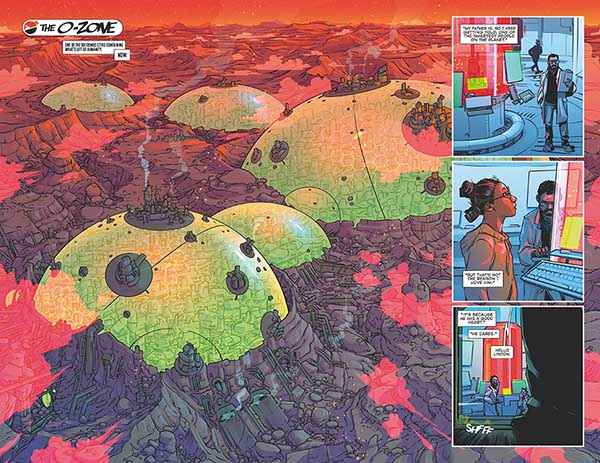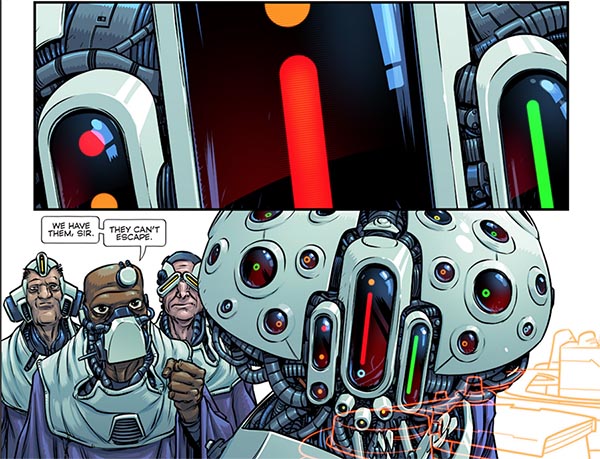Coming in November from Image Comics, Rob Williams and Pye Parr’s Petrol Head is a fast-paced foray into a future ravaged by climate change. It brings together an unlikely hotrod-racing robot and a 12-year-old girl as they embark on a quest to save humanity. We’ve seen the first issue at BF and it’s a cracking and much recommended piece of sci-fi escapism. We caught up with writer Rob Williams and artist Pye Parr to chat about the book’s cast of characters, embedding theme in visual storytelling, and a few easier questions like the state of US/UK politics in 2023…

ANDY OLIVER: “The Iron Giant Meets Mad Max” is the soundbite Image are using to promote the book. So let’s begin with the obvious question and ask you how you would describe both the premise of Petrol Head and its cast of characters?
ROB WILLIAMS: The Fast & The Robo-Furious is another good logline for it. Petrol Head is the story of a 12-year-old very smart girl called Lupa who goes on the run with her scientist father, because he thinks he has the cure for the climate emergency that has wracked the planet. The robot authorities of the domed city the remaining humans live in try to stop them getting the cure to the outside world, and Lupa and her father hide out in the garage of an old, grumpy, obsolete hotrod-racing robot, Petrol Head (and his friend, a sarcastic robot bird named Dave). When the robot cops come in heavy, Petrol Head has to do what he does best to get them all out of there – drive.
AO: As well as being a rollicking good action-adventure story there are obvious ecological themes to the series. What is it about science fiction as a genre do you think that makes it such an effective storytelling tool for social commentary?
WILLIAMS: You can cloud a pertinent or prescient idea behind fun characters and a thrilling story. Science fiction’s always been very good at that. There’s nothing remotely preachy about Petrol Head. We wanted this to be a fast-paced, funny adventure, is the bottom line. In fact the backdrop of a climate emergency really just evolved out of building our main character. Once Pye and I decided our main guy was a robot who literally was a ‘petrol head’ and he was an obsolete model who belched out smoke fumes, that just suggested some form of climate emergency theme.
PYE PARR: Yeah I like the contrast there – like Lupa and her father are trying to save the environment using some futuristic techno macguffin, but their only ally is a massive hunk of junk who constantly breathes out smoke. Likewise we’re rooting for them driving in this monstrously powerful hotrod, which smashes the crap out of everything it touches, but they live in a dome, presumably with finite resources, which protects them from an outside world wrecked by climate catastrophe. You can enjoy one thing whilst being aware of the other. Petrol Head doesn’t ask you one way or another how to feel about these things, just to enjoy the ride.
AO: The level of world-building in this first issue suggests you may have many more stories to tell about this environment. Can we expect more story arcs if there’s a positive reaction to this first one?
WILLIAMS: Our first arc is five issues, which is really six issues as #1 is double-sized. But we certainly intend this as an ongoing, probably in further ‘mini-series’’. The Hellboy model, effectively. Without giving too much away, by the end of this arc, we’ve only really explored one part of our city, The O-Zone, and issue one speaks of the seven domed cities containing what’s left of humanity. And our cast seems to expand issue by issue and they’re all characters we really like. There’s a lot of scope for more.
PARR: 100%. I’m absolutely in love with this series, and at the very least I want to keep Rob writing it so *I* can find out what happens!
AO: Can you give us some insights into the collaborative process between you both on the book?
WILLIAMS: The creation of the book was really us talking the ideas back and fore. Pye was posting these incredible posters of futuristic racing cars with robot drivers and it felt like a world just waiting to happen in a comic. I asked him if he’d considered that. Then it was a case of us creating a cool lead character – the classic 2000 AD model is you name your series after your lead – and building Petrol Head, Lupa, The O (our big baddie), Dave the robot bird and others.

Pye’s concept designs were terrific. We’d both offer ideas, like I’d say if The O was in charge or running every aspect of this city, he should have an enormous head for that size of brain. And then Pye adds to that by drawing it so he has tens of eyes all over that head. The scripts are full script from me. Then Pye draws and colours digitally. And his colours are a huge part of this book. Pye letters. Pye designs. Pye does a lot.
AO: Yes, what really strikes the reader visually about Petrol Head is how the distinctive colouring choices ramp up the tension and atmosphere considerably, and how the sound effects create such a sense of kinetic energy in the action sequences. Tell us a little about the thinking that went into those creative decisions?
WILLIAMS: We talked about books like Akira, about wanting to make the speed on the page kinetic which is a really tough thing to do in comics, but Pye’s done it here. I mean, this is essentially a story about futuristic races and car chases through an insane sci-fi city. It needed to be colourful and bright. We think we’ve created a book here that any audience can enjoy, regardless of age. This all came from Pye drawing amazing-looking robot racing drivers, and his colours pop like few in comics.
PARR: Nothing says artificial environments like horrible orange or neon strip lighting, and here you can’t escape from the orange glow of the sky/dome even when you’re outside, so that was my starting point – everything cast with false colour. Colour themes help the storytelling and the sense of place/time though too, as there’s 3 distinct environments in issue 1. ‘Outside’ where everything is either in the shadow of giant buildings or scorched by bright orange light from the sky/dome, ‘The Smogzone’: a kind of slum underneath everything else where the defunct robots live and all the waste and pollution generated by the rest of the city gets pumped. Here everything is sickly green and yellow and khaki which as well as making it look grim and dirty gives a nice contrast to the flashback of Petrol Head’s glory days where everything is so much brighter and more exciting. The last area is Inside: human habitats or offices where it’s all slightly sterile, white and pale blue.
I wanted to try and capture what I enjoy most about watching real motor racing: the way the cars weight shifts about and the chest-rattling noise as they go past – things quite hard to do in comics, as they’re both static and silent! So in the race/chase sequences we made the sfx as big and brutal and bouncy as possible, so they’re really IN with the cars, which are all stretched out at the edges to give it some movement and urgency, whilst keeping the colour very graphic. I’m not a big fan of blurring out linework either so I was keen to draw moving objects with lost edges but keep the hard lines without resorting to softening everything up.
AO: Pye, in terms of your artistic process what mediums did you work in to bring Petrol Head to life?
PARR: Normally I’d start with a page of pencils then scan and work digitally, but I switched entirely to digital for this book. I do page thumbnails and character sketches on my iPad, either in CSP or Procreate, then jump to my desktop for final art. I’ll letter my ‘pencils’ before doing the final linework to make sure everything fits and reads nicely (which is a good point for Rob to check it and make any changes he wants), and apart from some processing in Photoshop to make final print files I almost exclusively use Clip Studio Paint to ink and colour. For graphics and logos on car liveries I use Illustrator then paste onto the drawings afterwards.
AO: Rob, Cla$$war – your political super-hero thriller with Travel Foreman and Trevor Hairsine – was recently republished by Image. I feel we’re coming full circle here because when I interviewed you about the book nearly 15 years ago I asked you how you felt about its tone in what felt like a more optimistic moment in US politics. The pendulum has swung again, so how do you feel about the book’s themes now that Cla$$War feels more frighteningly relevant than ever?
WILLIAMS: Oof, that’s a complicated question and I’m not sure I know the answer. In an age of Trump and Boris and Brexit and post-truth and whatever nonsense we’re currently living in, the time of Cla$$war, which was written prior to George W Bush even getting the Republican nomination (but kind of based upon him) – that all seems a long time ago.
I think certain aspects in Cla$$war are timeless though, inasmuch as there will always be power hungry idiots who lie and are willing for others to suffer so they can achieve their aims. There’s something satisfying in a story about a super-powered person who is attempting to bring them to justice. And punch them. I’d quite like to see American – our lead in Cla$$war – punch Trump or Farage, I must admit. Apologies if that makes me a bad person.
AO: What else are you both working on right now? Are there any teases for future projects you can give us?
WILLIAMS: Petrol Head’s taking up a lot of my workload this year, but I also have a few longform Judge Dredds on the way. An 8-parter with PJ Holden and Pete Doherty called ‘Poison’ starts in the next 2000 AD jumping-on point Prog, 2351, which is out next week, I think. A few other Dredds are coming after that too.
PARR: I recently finished work on a board game called Joyride: Survival of the Fastest, for which I drew all the key art, boards, tokens and game pieces and stuff. It’s kind of like a top down version of Mario Kart but with a Mad Max aesthetic, and the game is really good fun. Whilst it’s completely separate from Petrol Head, I did work on it simultaneously and it’s full of brightly coloured crazy looking cars, so if you like the way the comic looks and feels I think you’ll dig it!
Interview by Andy Oliver





















